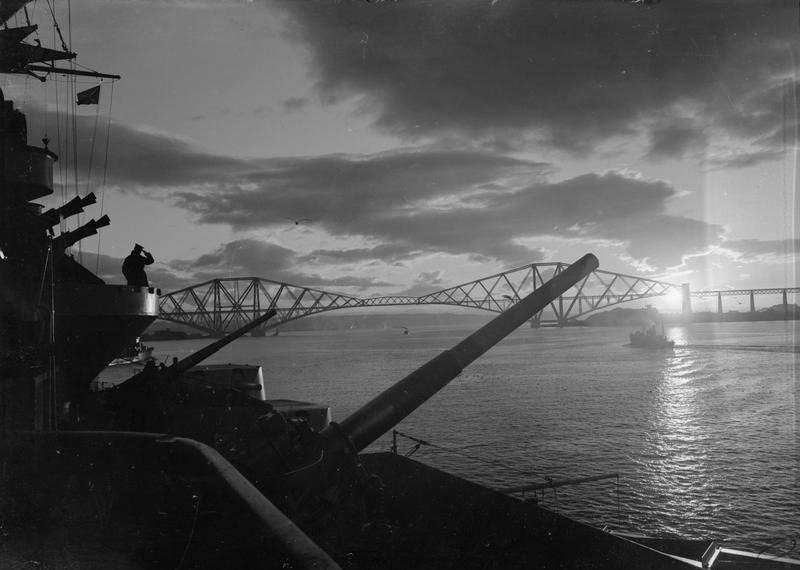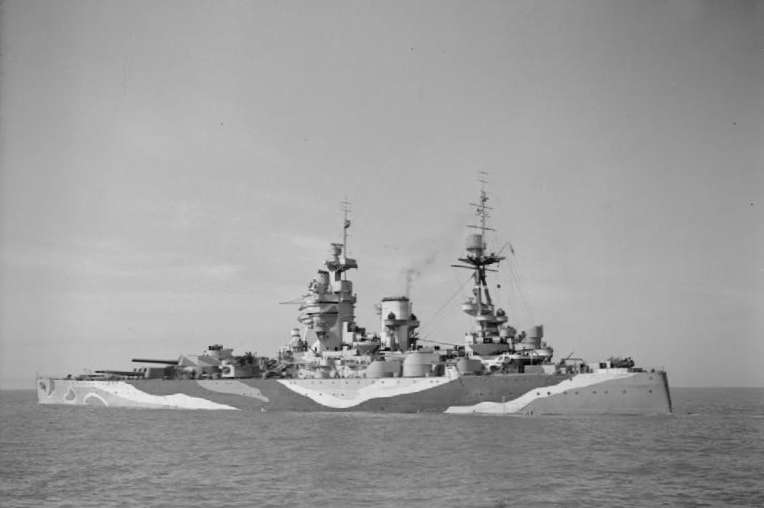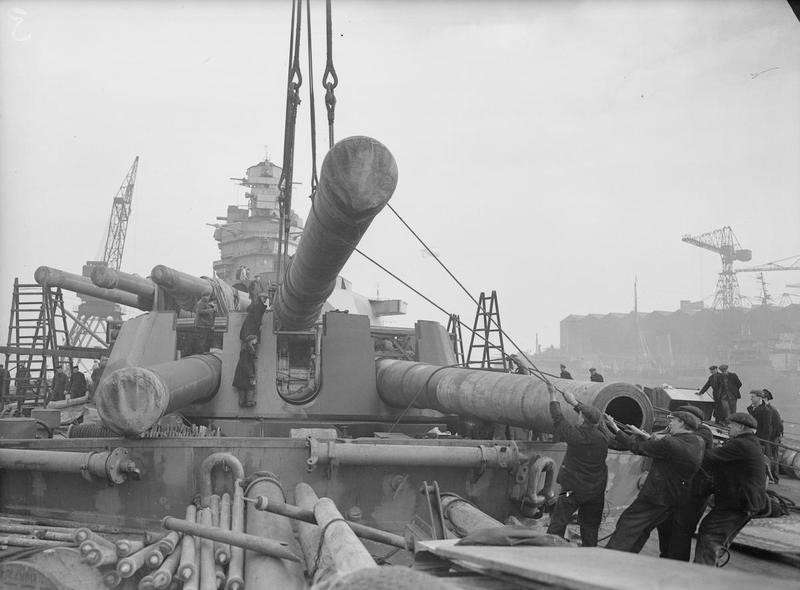The HMS Rodney, commissioned in 1927, was a unique and innovative British battleship, known for her distinctive design featuring all main guns forward of her superstructure.
Serving crucial roles during World War II, her notable contributions included the sinking of the German battleship Bismarck, escorting vital Atlantic and Mediterranean convoys, and providing effective bombardment support during the D-Day invasion.
Although decommissioned and scrapped post-WWII, HMS Rodney’s legacy as a versatile, resilient battleship continues to hold a significant place in British naval history.

Design Of HMS Rodney
Following World War I, the global naval landscape was fraught with the risk of an escalating arms race, as nations sought to expand and enhance their maritime capabilities.
To mitigate this, the major naval powers of the time convened in Washington D.C in 1922 to negotiate the terms of what would become known as the Washington Naval Treaty.
The treaty placed significant limitations on the size and armament of capital ships and led to the cancellation of many ongoing shipbuilding programs.
However, the treaty also offered room for innovation and creativity.
The British Royal Navy seized this opportunity and initiated the construction of two battleships – the HMS Nelson and HMS Rodney. They were part of the new Nelson-class of battleships that were a direct response to the treaty’s constraints.
The Rodney was an impressive ship, stretching 710 feet in length with a beam of 106 feet and a draught of 33 feet.
Its displacement was approximately 33,950 tons in standard conditions and over 38,000 tons when fully loaded for combat. It had a total complement of about 1,361 officers and crew, reflecting the complexity and manpower required to operate such a large warship.
The armament configuration was arguably the most striking feature of HMS Rodney.
 HMS Rodney underway after a refit in Liverpool.
HMS Rodney underway after a refit in Liverpool.
All nine of its 16-inch guns, which were the main battery, were placed forward of the superstructure.
This configuration, featuring three turrets with three guns each, was a significant departure from the more conventional layout of having turrets both fore and aft. This arrangement was primarily to save weight and comply with the tonnage restrictions imposed by the treaty.
The main guns had a maximum range of over 36,000 yards and were capable of firing both armor-piercing and high-explosive shells.
In addition to the main battery, the Rodney was also equipped with a secondary battery of twelve 6-inch guns, six 4.7-inch anti-aircraft guns, and a variety of smaller caliber anti-aircraft weapons that were added throughout the ship’s life.
The protective measures incorporated into the design of the Rodney were also unique. It utilized an ‘all or nothing’ armor scheme, where critical areas of the ship, such as the magazine and machinery spaces, were heavily armored, while less vital areas were left relatively unprotected.This approach aimed to ensure that the ship could remain operational even after taking significant damage in battle.
The Rodney’s belt armor, which protected the sides of the ship, was 14 inches thick, while the deck armor ranged from 3.25 to 6.25 inches.
The turrets and the conning tower were also heavily protected, with armor up to 16 inches thick.
Powering this massive ship were two Brown-Curtis geared steam turbines that generated 45,000 shaft horsepower, driving two propeller shafts.
The power plant could push the ship to a top speed of about 23 knots.
The Rodney had eight oil-fired boilers, which gave it a substantial range of approximately 7,000 nautical miles at a cruising speed of 16 knots.
Despite its innovative design, the Rodney was not without its flaws.
The placement of all the main guns forward led to issues with the living quarters, located behind the main battery, due to the concussion from firing.
Moreover, the ship had poor seakeeping characteristics, shipping large amounts of water over the bow in heavy seas.
Despite these drawbacks, the HMS Rodney’s design was groundbreaking and indicative of a new era in battleship design. While it was a product of restrictive treaty conditions, it demonstrated how innovation could work within such limitations to create a formidable and effective warship.
Pre-War Service and Modifications
After the HMS Rodney was commissioned into the Royal Navy in November 1927, she served in routine peacetime roles, joining the British Atlantic Fleet along with her sister ship, HMS Nelson. However, during the interwar period, the Rodney and other ships of the Royal Navy were subject to a series of modifications and enhancements.
These changes were made in response to emerging naval technologies and the ever-evolving nature of naval warfare.
Initially, Rodney performed standard peacetime duties such as exercises, maneuvers, and “showing the flag” missions around the globe. As a major warship in the Royal Navy’s fleet, she was a potent symbol of British naval power and was often called upon to represent Britain at major international events.
One such occasion was the Naval Review for King George V in 1937, where Rodney joined scores of other British and Commonwealth warships in a grand display of maritime power.
While the ship’s design was innovative for its time, new technologies and changes in naval warfare necessitated some improvements.
Recognizing the increasing threat of aerial warfare, the Rodney underwent a significant refit between 1929 and 1931. The modifications aimed to enhance the Rodney’s anti-aircraft capabilities, making her better equipped to defend herself against air attacks.
The refit involved the addition of eight QF 4-inch Mark V anti-aircraft guns and a single 2-pounder “pom-pom” gun, providing her with a formidable anti-aircraft armament.

HMS Rodney having new 16 inch guns fitted, 1942.
Also, two quadruple 0.5-inch Vickers anti-aircraft machine guns were installed for closer defense against aircraft. Rodney was also fitted with a catapult for launching and recovering reconnaissance seaplanes, further enhancing her scouting and spotting capabilities.
As a part of the refit, the Rodney also received upgrades to her armor.
Additional deck armor was installed to protect against plunging fire, which was becoming increasingly common as the ranges of naval artillery continued to increase. Also, the turret roofs, which initially had been somewhat lightly armored, were thickened to provide better protection against plunging shells and bomb strikes.
The interwar period was also marked by the regular maintenance and repairs necessary to keep the ship in fighting condition.
In particular, the Rodney suffered from recurring issues with her turbines and boilers, and much effort was expended in keeping them operational. Several significant repairs were undertaken to address these issues.
Early War Career
With the outbreak of World War II in 1939, the HMS Rodney transitioned from her peacetime roles to full combat readiness, playing crucial roles in several of the conflict’s major naval campaigns.
Rodney’s initial significant wartime engagement was the Norwegian Campaign in April 1940, marking Nazi Germany’s first direct conflict with British forces.
The campaign’s primary purpose was control over the Norwegian port of Narvik, essential for iron ore shipment from Sweden to Germany. The Rodney, along with several other Royal Navy vessels, was dispatched to counter the German invasion.
 HMS Rodney in the Firth of Forth, October 1940.
HMS Rodney in the Firth of Forth, October 1940.
Despite the campaign ending in a tactical defeat for the Allies, the British Royal Navy’s role was crucial, disrupting German naval forces and supply lines.
In addition to specific engagements, Rodney conducted regular patrols in the North Atlantic.
These patrols were a critical component of Britain’s broader naval strategy, aimed at safeguarding vital supply lines from North America and countering any potential surface threats from the German Kriegsmarine.
During these patrols, Rodney was tasked with escorting convoys, seeking out and engaging enemy surface vessels, and providing a potent deterrent to any German naval activity.
While no significant confrontations occurred during most of these patrols, they were crucial in maintaining the flow of resources vital to the British war effort.
The Sinking Of The Bismarck
Perhaps the most well-known and celebrated episode in HMS Rodney’s service history was her significant role in the sinking of the German battleship Bismarck in May 1941.
Bismarck, one of the two largest battleships ever built by Germany, set out on its maiden operation, codenamed Rheinübung.
The mission was to attack Allied shipping in the North Atlantic. After sinking HMS Hood, Britain’s pride and one of the world’s largest battleships, and damaging HMS Prince of Wales, the Bismarck became a significant threat that had to be dealt with immediately.
Following the sinking of the Hood, the Royal Navy mobilized a portion of its fleet to find and destroy the Bismarck.
This included the HMS Rodney, which was ordered to join the chase, detouring from a mission to America for a refit.
On May 27, 1941, Rodney, along with King George V and several other British ships, found and engaged the Bismarck. Rodney’s role in this battle was critical. Armed with nine 16-inch guns, she was one of the few ships in the world that could effectively penetrate Bismarck’s heavy armor.
During the battle, Rodney fired many of shells at the Bismarck, with several scoring direct hits.

One of Rodney’s salvoes is believed to have hit the Bismarck’s command area, potentially killing many of the German ship’s senior officers and effectively decapitating the enemy vessel.
Remarkably, during the engagement, Rodney also made naval history by becoming the only battleship to have successfully torpedoed another battleship.
Rodney launched two torpedoes from her port-side underwater torpedo tubes, one of which hit the Bismarck, causing further damage.
The battle ended with the sinking of the Bismarck, which marked a major victory for the Allies and boosted British morale.
For Rodney, this was undoubtedly the pinnacle of her service. Her firepower and armor were instrumental in neutralizing the Bismarck, one of the most significant threats to the Allied naval and merchant fleets.
Operation Pedestal
The Atlantic lifeline, the shipping route from North America, was a critical part of Britain’s war strategy. As German U-boats threatened this lifeline, large warships like Rodney were required to safeguard convoys. These duties were essential but risky, as it opened up the potential for attacks from enemy submarines and aircraft.
In August 1942, Rodney took part in one of the most fiercely contested convoy missions of the war – Operation Pedestal.
The objective was to supply the besieged island of Malta, a British colony in the Mediterranean and a strategic location for operations in North Africa and Southern Europe.
Rodney’s role in Operation Pedestal was to provide convoy protection as the ships made their way from Gibraltar to Malta.
She was part of Force Z, a group of capital ships assigned to provide distant cover for the convoy. Her massive guns were a potent deterrent to any potential surface attack from the Italian fleet.
The operation was a high-stakes gamble. Malta was on the brink of surrender due to shortages of food, fuel, and military supplies, and the convoy was its last hope.
The mission was fiercely opposed by German and Italian forces, leading to numerous losses for the convoy. However, thanks to the escorts’ determined efforts, enough of the convoy managed to reach Malta, allowing the island to hold out.
HMS Rodney On D-Day
As World War II reached its climax, HMS Rodney found herself at the forefront of the Allied invasion of Normandy, colloquially known as D-Day, on June 6, 1944.
In preparation for the invasion, the Rodney underwent further modifications. In addition to her already formidable armament, she was equipped with extra AA (Anti-Aircraft) weaponry to better defend against potential Luftwaffe attacks.
Furthermore, crews trained rigorously in shore bombardment tactics, an important task the Rodney was slated to perform.
On D-Day, the Rodney was tasked with supporting British and Canadian forces landing at Juno and Gold beaches. From the early morning hours, she used her 16-inch guns to fire on German coastal defenses, helping to neutralize these positions before the landings.
The sheer power of Rodney’s guns, some of the largest in the entire invasion fleet, proved instrumental in suppressing German fortifications and clearing the way for the invading Allied troops.
 HMS Rodney firing her guns on D-Day.
HMS Rodney firing her guns on D-Day.
Over the course of the invasion, the Rodney fired hundreds of shells, providing a constant barrage to disrupt German defenses.
The precision and volume of fire she was able to deliver greatly assisted the advancing Allied forces, underscoring the pivotal role of naval bombardment in supporting amphibious operations.
Following the successful invasion of Normandy, the Rodney continued her duties in European waters. She was primarily involved in patrolling the English Channel and North Sea, ensuring that these crucial waterways remained free from enemy activity.
As the war drew to a close, Rodney participated in Operation Mascot, an unsuccessful attempt to sink the German battleship Tirpitz, the sister ship of the Bismarck.
Decommissioning and Legacy
With the conclusion of World War II, the Royal Navy faced the task of demobilization and reassessing its fleet’s needs in a rapidly changing world. Battleships, once the backbone of naval power, were increasingly being eclipsed by the rising prominence of aircraft carriers and submarines.
HMS Rodney, a veteran of numerous crucial battles, was among the warships affected by these changes.
After her wartime service, HMS Rodney was briefly retained on active duty but was placed in reserve by 1946 due to a combination of factors.
Her age, the high cost of maintaining a battleship, and the changing nature of naval warfare all contributed to this decision.
In 1948, the Rodney was sold for scrap, marking the end of her over two decades of service to the Royal Navy.
Her dismantling was carried out by Thos W Ward at Inverkeithing, Scotland. The decommissioning and scrapping of such a storied battleship marked the end of an era for the Royal Navy.
Even after her decommissioning, Rodney continues to hold a special place in British naval history. Her name and legacy continue to inspire naval officers and history enthusiasts alike.
She is a testament to the resilience, determination, and technological prowess of the Royal Navy during some of the most challenging periods of the 20th century.
While HMS Rodney may no longer be afloat, her impact and legacy are undiminished. She stands as an enduring symbol of the crucial role battleships played in shaping world history during the first half of the 20th century.
News
The “Red Zone” – Land Still Abandoned Due to the Dangers Left by the First World War
The “Red Zone” – Land Still Abandoned Due to the Dangers Left by the First World War In the aftermath of the First World War, large areas of northeast France were left in ruin. Years of constant siege warfare along…
Before Becoming a Big-Name Actor, Richard Todd was a Paratrooper Who Fought at Pegasus Bridge
Before Becoming a Big-Name Actor, Richard Todd was a Paratrooper Who Fought at Pegasus Bridge Photo Credit: 1. Sgt. Christie, No. 5 Army Film & Photographic Unit / Imperial War Museums / Wikimedia Commons / Public Domain 2. Silver Screen…
The Potsdam Giants: A Prussian Infantry Regiment Of Nothing But Very Tall Soldiers
The Potsdam Giants: A Prussian Infantry Regiment Of Nothing But Very Tall Soldiers Frederick William I inspecting his giant guards known as The Potsdam Giants, a Prussian infantry regiment No 6, composed of taller-than-average soldiers. Frederick William I of Prussia,…
Ellen DeGeneres cuts a very casual figure as she drives around in her Ferrari
Ellen DeGeneres cuts a very casual figure as she drives around Montecito in her Ferrari… while preparing to embark on her stand-up tour Ellen DeGeneres cut a very casual figure as she made her way around Montecito on Tuesday morning. The…
“I’m heavily tattooed and keep getting rejected for jobs – it’s not fair”
Heavily tattooed OnlyFans star, 23, with multiple piercings on her FACE slams TJ Maxx for rejecting her for a job – accusing retailer of unfairly judging her dramatic look A woman has accused TJ Maxx of rejecting her for a…
All 75 passengers killed in plane crash after pilot let his chirldren control the plane
Praying, turning the engine off by accident and letting KIDS play with the controls: The worst blunders made by pilots before a crash revealed Every time we board a plane, we put our lives in the hands of the pilot….
End of content
No more pages to load











